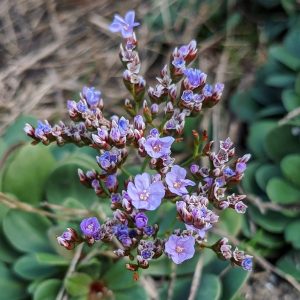Sicilian Sea Lavender (Limonium hyblaeum), a cushion-forming endemic to Sicily’s rocky south-east coasts, only described as a separate species in 1980, by which time it had been spread to the UK and Australia.
A relative of the now common amenity planting Limonium perezii, it is possible that Sicilian Sea Lavender was introduced into Australia by several vectors, including shipping ballast and the nursery trade. Once established, the species has been spread mechanically on vehicles and boots; reviews c. 2012 found sites along the Great Ocean Road where infestations centred on visitor car parks.
Sicilian Sea Lavender was first recorded on this continent at Port Adelaide in 1889, where it had established around the Lefevre Peninsula and Port River. It had spread to Port Lincoln SA by 1932 and to the Yorke Peninsula by 1961. A separate naturalisation appears to have occurred in Western Australia around Perth, where it has also been recorded from the c. 1960s. In 1982 the plant was found at Cape Northumberland, just 25 kilometres from the Victorian border, an infestation which I saw first hand last month.
In 1984 the plant was formally collected at Port Fairy in this state, and it has since been spread to a number of coastal sites west of Cape Otway. In 2004, the species was also collected at the former Cheetham Saltworks at Moolap, east of Geelong, colonising management tracks on narrow empondment berms within the saltworks. Despite previous management efforts, the Moolap population remains extant and is photographed here. Able to colonise a range of salt-sprayed substrates, from dune sand to gravels, boulderfields and exposed rock crags, sometimes forming smothering carpets, and capable of spreading both vegetatively and by apomictic (asexual) seed production, this tiny marginal plant has been identified as a serious threat to Victoria’s most valued salt marsh complexes.
View Original Post on Instagram
Search for information about Limonium hyblaeum in the Flora of Victoria
View information and occurrences of Limonium hyblaeum on the Atlas of Living Australia










